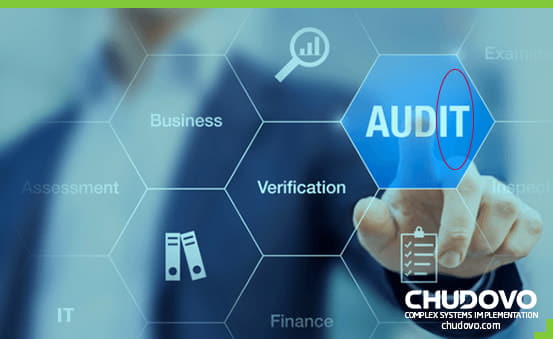
Shielding Your Business: Unraveling the Power of IT Audit for Business Security
In today’s world, businesses face various security threats, from cyber attacks to natural disasters. To protect their digital assets, businesses need to take a proactive approach to security, and one of the most effective ways to do so is through IT audit. By conducting regular IT audit, businesses can identify vulnerabilities in their IT infrastructure, assess their risk posture, and implement controls to protect their digital assets better.
Table of content:
- The Importance of IT Audit in Cybersecurity
- Identifying Vulnerabilities Through IT Audit
- The IT Audit Process
- Emerging Trends in IT Audit Practices
- Risk Assessment in IT Audit
- Securing Digital Assets with IT Audit
- Managing Cyber Threats with IT Audit
- IT Audit for Regulatory Compliance
- Role of IT Audit in Data Protection
- Improving Business Resilience with IT Audit
- Conclusion
- FAQ

The Importance of IT Audit in Cybersecurity
IT audit play a crucial role in protecting businesses from cybersecurity threats. By conducting regular IT audit, organizations can identify vulnerabilities in their IT infrastructure, assess their risk posture, and better implement controls to protect their digital assets. This section will explore the importance of IT audit in cybersecurity.
- Identifying Vulnerabilities
One of the main benefits of IT audit is their ability to identify vulnerabilities in an organization’s IT infrastructure. By comprehensively evaluating the organization’s IT infrastructure, policies, and procedures, IT auditors can identify weaknesses that hackers or other malicious actors could exploit. This helps organizations proactively address these vulnerabilities before they can be used.
- Assessing Risk Posture
IT audit for business security also helps organizations assess their risk posture. By evaluating the organization’s IT infrastructure, policies, and procedures, IT auditors can identify areas of high risk and provide recommendations for mitigating those risks. This helps organizations prioritize their cybersecurity efforts and allocate resources more effectively.
- Improving Security Posture
IT audit can also provide recommendations for addressing identified vulnerabilities and improving an organization’s security posture. By implementing these recommendations, organizations can better protect their digital assets and reduce the risk of cyber attacks.
- Compliance
Many industries are subject to regulatory requirements related to information security. IT audit can help organizations comply with these requirements and avoid costly penalties for non-compliance.
- Disaster Recovery
Disaster recovery is critical to business continuity planning. IT audit can help organizations identify potential points of failure in their disaster recovery plans and provide recommendations for addressing those vulnerabilities. This helps organizations ensure they are prepared to respond to a disaster and minimize the impact on their business operations.
Identifying Vulnerabilities Through IT Audit

One of the primary IT audit benefits for businesses is their ability to identify vulnerabilities in an organization’s IT infrastructure. By comprehensively evaluating the organization’s IT infrastructure, policies, and procedures, IT auditors can identify weaknesses that hackers or other malicious actors could exploit. This helps organizations proactively address these vulnerabilities before they can be used.
Penetration Testing
One of the most effective ways to identify vulnerabilities is through penetration testing. Penetration testing involves simulating an attack on an organization’s IT infrastructure to identify weaknesses that hackers could exploit. By conducting penetration testing, organizations can identify and address vulnerabilities before they can be controlled.
Vulnerability Scanning
Another effective way to identify vulnerabilities is through vulnerability scanning. Vulnerability scanning involves using automated tools to scan an organization’s IT infrastructure for known vulnerabilities. By conducting vulnerability scanning, organizations can identify vulnerabilities and take steps to address them before they can be exploited.
Risk Assessment
Risk assessment is another important component of identifying vulnerabilities. By assessing the risks associated with an organization’s IT infrastructure, policies, and procedures, IT auditors can identify areas of high risk and provide recommendations for mitigating those risks. This helps organizations prioritize their cybersecurity efforts and allocate resources more effectively.
Certified engineers Convenient rates Fast start Profitable conditions Agreement with English and German
EU company
speaking engineers
Compliance Assessment
Compliance assessment is another critical component of identifying vulnerabilities. Many industries are subject to regulatory requirements related to information security. By conducting compliance assessments, organizations can ensure that they comply with these requirements and avoid costly penalties for non-compliance.
The IT Audit Process
The IT audit process is a comprehensive evaluation of an organization’s information technology infrastructure, policies, and procedures to ensure they effectively support its goals and objectives. The IT audit process typically involves several phases, including planning, fieldwork, report writing, and follow-up.
1. Planning Phase
The Planning phase is the initial step in the IT audit process. During this phase, the audit team will define the audit scope, identify the audit objectives, and develop the audit plan. The audit team will also determine the audit approach and select the IT audit tools and techniques they will use to conduct the audit. The planning phase is critical to the audit’s success, laying the groundwork for the entire process.
2. Fieldwork Phase
The Fieldwork phase is the core of the IT audit process. The audit team will gather evidence, test controls, and document findings during this phase. The audit team will use a variety of IT audit techniques, such as interviews, documentation review, and observation, to collect evidence. The audit team will also test the effectiveness of the organization’s controls to ensure that they are working as intended. This phase requires the most time and effort from the audit team.
3. Report Writing Phase
The Report Writing phase is where the audit team documents their findings and recommendations in a formal report. The report should be clear and concise and include sufficient evidence to support the conclusions and recommendations. The information should also include a summary of the audit objectives, scope, and approach and an executive summary that highlights the most significant findings and recommendations.
4. Follow-up Phase
The Follow-up phase is the final step in the IT audit process. During this phase, the audit team will monitor the implementation of their recommendations. The audit team will work with the organization to ensure that their recommendations are implemented effectively and that any issues are addressed promptly. The follow-up phase is critical to ensuring the organization makes the necessary changes to improve its IT infrastructure, policies, and procedures.
Emerging Trends in IT Audit Practices

IT audit continue to play a critical role in enhancing business security with IT audit by identifying vulnerabilities in IT infrastructure, policies, and procedures. IT audit have become even more important in today’s cybersecurity landscape as businesses face increasing cyber threats. IT audit can help businesses protect their data by identifying vulnerabilities and providing recommendations for addressing them. As such, IT audit are a critical component of any cybersecurity strategy.
Increased Focus on Data Security
In today’s digital age, businesses handle increasingly sensitive data. As a result, IT audit have become increasingly important to maintain data security. In order to achieve this, IT audit strongly emphasize evaluating the effectiveness of security controls, identifying potential vulnerabilities, and ensuring that access controls are appropriate for the data being handled. It is important to note that data security is a legal requirement and a moral obligation businesses have to their customers and clients. Thus, IT audit play a crucial role in helping businesses meet these obligations and maintain the trust of their stakeholders.
Emphasis on Privacy Compliance
In light of recent data breaches and regulations such as GDPR and CCPA, privacy compliance has become a top priority for many businesses. This trend is not surprising given the increasing amount of sensitive data that companies handle and customers’ heightened awareness regarding data privacy. Businesses must take a proactive approach to privacy compliance, which includes conducting regular IT audit to assess the effectiveness of privacy controls, identifying potential vulnerabilities, and implementing measures to mitigate risks. Furthermore, businesses must ensure that they meet regulatory requirements, which can be complex and challenging given the evolving nature of privacy laws and regulations. Failure to comply with these regulations can result in significant penalties and reputational damage, which can have long-lasting consequences.
Integration with Risk Management
IT audit is becoming more and more important as technology continues to advance at a rapid pace. As businesses become more reliant on technology, the risks associated with IT also become more complex and varied. To address these risks, IT audit are now being integrated with broader risk management practices. This allows businesses to take a more comprehensive approach to managing their security risks, which is critical in today’s ever-evolving threat landscape. By aligning IT risks with overall business objectives, companies can better prioritize their security efforts and ensure they are adequately protected against potential threats. This integration also helps improve communication between different departments within a company, leading to more effective risk mitigation strategies and better overall business outcomes.
As businesses face ever-increasing security threats, IT audit will continue to play a critical role in protecting data with IT audit. By staying abreast of emerging trends in IT audit practices, businesses can better prepare themselves for future security challenges.
Risk Assessment in IT Audit
- Identify assets
The first step in risk assessment is identifying the assets that need protection. This can include physical assets, such as servers and network equipment, and digital assets, such as databases and intellectual property.
- Identify threats
Once the assets have been identified, the next step is identifying the threats that could impact those assets. This can include both internal and external threats, such as hackers, malware, and natural disasters.
- Assess vulnerabilities
With the assets and threats identified, the next step is to assess the vulnerabilities that those threats could exploit. This can include technical vulnerabilities, such as outdated software, and operational vulnerabilities, such as weak passwords or lack of employee training.
- Determine likelihood and impact
After assessing vulnerabilities, the next step is to determine the likelihood and impact of a successful attack. This can help prioritize which vulnerabilities should be addressed first.
- Determine risk level
Based on the likelihood and impact, the final step is to determine the overall risk level of each asset. This can help organizations allocate resources more effectively to address the most critical vulnerabilities first.
By following these steps, organizations can conduct a comprehensive risk assessment as part of their IT audit process. This can help identify potential vulnerabilities and threats to their digital assets and provide recommendations for addressing them and improving their overall security posture.
Securing Digital Assets with IT Audit
Securing digital assets is crucial to any business. IT audit are an effective way to ensure that your organization’s digital assets are protected against various security threats. An IT audit is a comprehensive evaluation of an organization’s information technology infrastructure, policies, and procedures to ensure that they effectively support the organization’s goals and objectives.
One of the most significant benefits of IT audit is that they help businesses identify vulnerabilities in their IT infrastructure that cybercriminals could exploit. By conducting regular IT audit, businesses can identify vulnerabilities in their systems and applications and implement controls to address them. These controls can include firewalls, intrusion detection systems, and security information and event management (SIEM) systems, which can help businesses detect and respond to security threats more effectively.
In addition to protecting against external threats, IT audit can also help businesses identify and address internal threats, such as employee negligence or intentional misconduct. By implementing access controls and monitoring employee activity, businesses can reduce the risk of insider threats.
IT audit can also help businesses ensure compliance with regulatory requirements related to information security. Regulations such as HIPAA, PCI DSS, and GDPR require organizations to take specific steps to protect sensitive data. Conducting regular IT audit can help businesses ensure that they are in compliance with these regulations and avoid costly penalties for non-compliance.
Moreover, IT audit can also help businesses identify potential points of failure in their disaster recovery plans and provide recommendations for addressing those vulnerabilities. Disaster recovery is a critical component of business continuity planning, and IT audit can help businesses ensure that their disaster recovery plans are effective and up-to-date.
Managing Cyber Threats with IT Audit
In today’s digital landscape, cyber threats have become a major concern for businesses of all sizes. Cybercriminals constantly find new and innovative ways to breach an organization’s IT infrastructure and steal sensitive data. This has made it imperative for businesses to take a proactive approach to security and implement effective strategies to safeguard their digital assets.
One of the most effective ways to protect against cyber threats is through regular IT audit. IT audit can help businesses identify vulnerabilities in their IT infrastructure that cyber criminals could exploit. These vulnerabilities include weak passwords, outdated software, unsecured wireless networks, and more. By identifying these vulnerabilities, businesses can take steps to mitigate the risks and implement controls to better protect their digital assets.
In addition to identifying vulnerabilities, IT audit can also provide recommendations for addressing them. These recommendations could include installing software patches, implementing security protocols, upgrading hardware, etc. By implementing these recommendations, businesses can improve their security posture and protect their digital assets from cyber threats.
Moreover, IT audit can also help businesses assess their overall risk posture. By evaluating the effectiveness of their current security measures, businesses can identify areas where they need to improve and implement controls to reduce their overall risk. This can help businesses stay ahead of the curve and better defend against emerging threats.
IT Audit for Regulatory Compliance
Many industries are subject to regulatory requirements related to information security. Non-compliance with these regulations can result in costly penalties, legal action, and reputational damage. Regular IT audit can help businesses ensure that they comply with these regulations.
IT audit can help businesses identify potential vulnerabilities and assess their risk posture regarding regulatory compliance. The audit evaluates the organization’s IT infrastructure, policies, and procedures to meet regulatory standards. The audit report will provide recommendations for addressing any gaps or non-compliance issues found during the audit.
In some cases, regulatory compliance requirements may change over time, and businesses must ensure that their IT infrastructure evolves to meet these changes. Regular IT audit can help businesses stay up-to-date with the changing regulatory landscape and avoid penalties for non-compliance.
Moreover, IT audit can help businesses build trust with their clients and partners. Clients and partners want to work with businesses that take data protection and regulatory compliance seriously. Regular IT audit demonstrate a commitment to these principles and can help businesses differentiate themselves from their competitors.

Role of IT Audit in Data Protection
IT audit is essential in ensuring that an organization’s data is protected from unauthorized access, modification, or destruction. They comprehensively assess an organization’s information systems and identify potential vulnerabilities that may compromise data security.
IT audit involve a review of an organization’s hardware, software, and networking infrastructure, as well as an assessment of the organization’s policies and procedures for data management. The goal is to identify any weaknesses in the system and recommend changes that will improve data protection.
Some of the key benefits of IT audit in data protection include:
- Identification of security risks and vulnerabilities
- Evaluation of the effectiveness of security controls
- Improvement of data management policies and procedures
- Enhanced compliance with legal and regulatory requirements
- Reduction of the risk of data breaches and cyber attacks
In today’s digital age, data protection is critical for organizations of all sizes. Organizations can ensure their data is secure and protected from potential threats by conducting regular IT audit.
Improving Business Resilience with IT Audit
In today’s digital age, businesses increasingly rely on technology. However, this reliance also makes them vulnerable to various risks, such as cyber-attacks, system failures, and other disruptions that can cause significant financial and reputational damage. That’s why companies need to protect themselves from these risks and improve their overall resilience.
One way of doing this is by conducting IT audit. By identifying potential vulnerabilities in their IT systems, companies can take steps to mitigate risks and improve their overall resilience. During an IT audit, an auditor will review a company’s IT infrastructure, policies, and procedures to identify areas for improvement. A company can better protect itself from cyber attacks, system failures, and other disruptions by addressing these areas.
IT audit are particularly important for businesses storing sensitive data, such as financial or personal data. This data breach can have serious consequences for the company and its customers. Companies can ensure that their IT systems are secure and comply with relevant regulations and industry standards by conducting regular IT audit.
In addition to improving overall resilience, IT audit can help businesses comply with regulations and industry standards. By demonstrating that they have effective IT controls in place, businesses can gain the trust of customers, partners, and regulators. This can help them to attract new business, retain existing customers, and avoid costly fines or legal action.
Conclusion
Strengthening business cybersecurity is more important than ever in today’s digital age, where cyber threats are becoming increasingly sophisticated and frequent. IT security best practices, including regular IT audit, are essential for businesses to protect their digital assets and maintain their trust with customers and partners.
The IT audit process explained in this document involves a comprehensive evaluation of an organization’s information technology infrastructure, policies, and procedures to support its goals and objectives effectively. Organizations can improve their overall resilience and compliance with regulatory requirements by identifying vulnerabilities, assessing risk posture, and implementing controls to protect digital assets better.
FAQ
What is an IT audit?
An IT audit is a comprehensive evaluation of an organization’s information technology infrastructure, policies, and procedures to ensure that they effectively support the organization’s goals and objectives.
How can IT audit help improve business security?
IT audit can help identify vulnerabilities in an organization’s IT infrastructure and provide recommendations for addressing them. By implementing these recommendations, organizations can improve their security posture and better protect their digital assets.
How often should organizations conduct IT audit?
The frequency of IT audit depends on several factors, including the size and complexity of the organization’s IT infrastructure, the industry in which it operates, and its risk tolerance. In general, organizations should conduct IT audit at least once a year.
What is the IT audit process?
The IT audit process typically involves several phases: planning, fieldwork, report writing, and follow-up. During the planning phase, the audit team will define the audit scope, identify the audit objectives, and develop the audit plan. During fieldwork, the audit team will gather evidence, test controls, and document findings. The audit team will document their findings and recommendations in a formal report during the report-writing phase. Finally, during the follow-up phase, the audit team will monitor the implementation of their recommendations.




